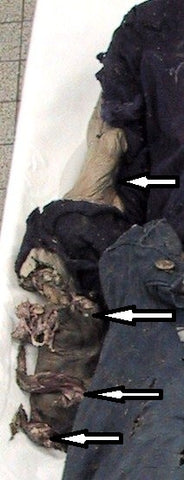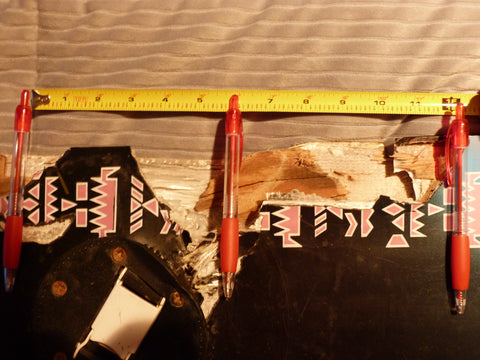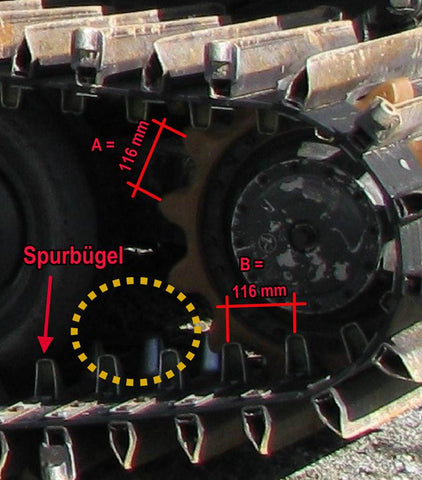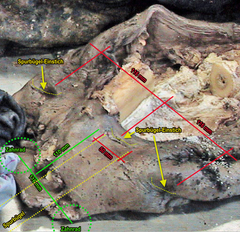Duncan MacPherson's Death: Forensics
Glacier Ice Flow or Contact with Machinery?
Speaking about the condition of Duncan MacPherson's body for a 2006 Canadian television documentary, Dr. Walter Rabl of the Innsbruck Institute of Forensic Medicine stated:
I saw such damages on glacier corpses. Yes. During the movement in the ice, the glacier breaks the body. But the injuries itself, I could not examine exactly. We saw the clothed body, but we did not unclothe it. .... We never, ever did an autopsy; we just had to do the identification [of the body].
In other words, Dr. Rabl assumed that Duncan's injuries had been caused by ice movement, but he had not (for some reason) been able to confirm this assumption by looking closely at the injuries. Fortunately, Dr. Rabl took photographs of the corpse, and the MacPherson family ultimately obtained copies of them.
Below: Overview of body lying on gurney at Innsbruck Institute of Forensic Medicine. Though the body remained at the Institute for over a week, NO official autopsy or even external examination was performed, though photographs were taken.
1) Forearms and hands are amputated.
2) The left leg has been amputated just above and just below the knee. Lower left leg is completely destroyed; the right leg is completely intact. How could glacier ice flow chop one leg into pieces and leave the other leg (lying next to it in the crevasse) completely intact?
NOTE: The forensic doctor, Walter Rabl, removed a section of the left femur with a bone saw, purportedly for DNA testing.
3) In addition to bone fractures, the soft tissue has been ground, avulsed, and de-gloved--injuries consistent with rotating machinery.
4) The clothing is cut and torn. The denim shorts on the left thigh have been shredded, the left gaiter has been ripped.
5) The pieces of all of his limbs were found together with the body. Natural dismemberment from ice flow would have separated the pieces.



As I recount in Cold a Long Time: An Alpine Mystery, I showed these images to a number of forensic experts, a ski accident investigator, and a prominent glaciologist. I also read extensively about the physics of glaciers and the strange phenomenon of glacier corpses.
Depending on the section of the glacier into which a body falls, it may be subjected to significant forces from the flowing ice. In the upper region of the glacier -- the so called accumulation zone--the body will be directed into deeper layers of ice and subjected to compressive stress that may crush the cranium and ribcage. In the lower region of the glacier--the so-called ablation zone--the body will be subjected to tensile stress that may dismember it. Pieces of the body may be ultimately be found at the bottom of the glacier at different times and in different locations.
Duncan's body did not go into a deep crevasse; it was neither crushed nor pulled apart. Three of his limbs display sharp, linear fractures along the bone shafts, with extensive avulsion of muscle, tendon, and skin. Moreover, all three of the amputated limbs were found with the torso. As the glaciologist David Evan's pointed out, this is an obvious indication that they were NOT fractured by glacier sheer stress, which would have displaced the fractured limbs on either side of the sheer plane. It is also notable that the snowboard found immediately adjacent to Duncan's body in the vestige of a shallow crevasse was not broken by glacier sheer stress, but by the action of heavy machinery.
Upon examining the radiographs and photographs of Duncan's body, several forensic and medical experts, including the renowned forensic anthropologist Myriam Nafte and the criminalist Lynne Herold have agreed that his limbs bear the characteristic injury patterns caused by machinery.


Above: Close-up of the only radiograph submitted to the MacPhersons that shows any (a small section) of the left leg. The ends of the diagonal line indicate where the femur fractured just above the knee joint. The top, horizontal arrows indicate where Dr. Rabl removed a section of the femur for a DNA sample. The bottom, vertical arrows indicate the multiple fractures of the tibia -- "like his leg went into a blender," as the Saskatoon radiologist Dr. Burbridge put it.

Above: Side view of the left leg. The verticle arrows indicate where the leg was cut all the way through. The upper right horizontal arrows indicate the degloving of flesh around the top of the detached knee. The skin and subcutaneous tissue have been peeled downward, towards the lower leg. The above photo also displays a piece of cord that does NOT belong to Duncan's clothing or equipment.

Above: Artist's rendering of the detached left knee.

Above: Duncan's left foot has been severed and the tendons (white strands) have been pulled out. The arrow indicates a deep gouge on the left side of the heel. Just behind and to the right of the foot is Duncan's right hand with missing fingers. The vertical arrow indicates where his thumb was cut off: Note the white tendon strand that has been pulled out. Top horizontal arrow indicates large mass of tendons that have likewise been pulled out. These injuries are consistent with a rotating machine that has broken and twisted the bone and joints at the same time. Finally, note the dark color of the injured surfaces, indicating that the injuries occurred long before the body was extracted from the ice

Dr. Rabl took the above photograph shortly after Duncan's remains arrived at the Innsbruck Institute of Forensic Medicine on the morning of July 22, 2003, still fully frozen from cold storage at the funeral home. The plastic sack contains pieces of Duncan's limbs, including his entirely detached left knee, his left foot, and his right hand. Note the white tendon strands that have been pulled out. Finally, note how the pieces appear to be adhering together in a compact assembly, as though they were frozen in this position.


Above: Right Arm. The bottom arrow indicates where the forearm was severed a few inches above the wrist. The severed lower limb is lying upside down on the gurney. Second from bottom arrow indicates tendons that were pulled out. The third from the bottom arrow indicates where the fingers were cut off. The top arrow indicates the completely undamaged upper arm. The relatively weak shoulder joint is also intact, indicating that little or no force was applied to it in the ice. The tear pattern on the shirt sleeve is consistent with the bottom of the sleeve getting caught in machinery and violently pulled.

Above: Severed left hand. Note the linear quality of the cut. The arrow indicates where the forearm was also severed a few centimeters above the wrist.


Above: Sites on Duncan's knee where a hard object has gouged the skin all the way to the bone, presumably in same mechanical action that amputated his lower left leg.

When Did Duncan's Limb Fractures Occur?
Three forensic experts to whom I showed photos of Duncan's body independently stated that the limb fractures had occurred long before Duncan's body was extracted from the ice, as the fractured surfaces were the same aged color as the rest of the bones. Even Dr. Rabl, who proposed the alternative hypothesis that Duncan's limbs were damaged by ice flow, stated the following in his Feb. 13, 2004 email to Lynda MacPherson:
In my opinion the main damages of the body of Duncan were not produced during the recovery of the corpse in 2003, because the fractured surfaces of the bones were dark brown and grey colored--fresh fractures would have been much lighter.
The Condition of Duncan's Snowboard
On July 28, 2003, Bob MacPherson pointed out to Dr. Rabl that the snowboard appeared to have been damaged by a machine, and he asked if Rabl knew what had caused the damage. Rabl replied that he would inquire, and (with the MacPhersons in his office) he called the Stubai Glacier slope maintenance to inquire how the workers had recovered it. It strikes me as strange that Rabl did not inquire about the snowboard damage earlier, given that the snowboard arrived with Duncan's body at his institute on July 22, 2003.

Above: The snowboard and left boot liner as they were presented in the transport coffin to the Innsbruck Institute of Forensic Medicine on the morning of July 22, 2003. The black arrows indicate where the plastic laminate has been ripped away from the underlying plywood. Note how the wood and paint are deeply weathered, indicating that these materials were exposed to ice and water long before the snowboard was extracted from the ice just three days earlier.
According to Dr. Rabl, Stubai Glacier slope maintenance informed him that they'd recovered Duncan's body as carefully as possible using picks, but had found it necessary to use a snow groomer in order to dig out the snowboard. As Rabl recounted in an Aug. 5, 2003 email to Bob, "First they pulled on the snowboard and thereby broke it to pieces" and then "ran over it with the Ratrak [groomer]." Bob MacPherson immediately found this suspicious. There were no points on the board for attaching a winch cable or recovery strap, and none of the equipment on a groomer was suitable for excavating objects from ice. As I relate in my book, I consulted a ski accident investigator who entirely agreed with Bob. As he pointed out, the damage to the snowboard has a uniform pattern. The angles of the cuts are identical to the angles of the two breaks. In other words, the board had not been "pulled on, broken into pieces, and then run over" -- it had simply gone through a machine.

Above: Close-up of damage to left side of the snowboard. The arrows indicate where the board was cut three times at the same angle. The crescent-shaped cuts decrease in depth from left to right. Measured from the left side of each cut, a distance of six inches (15.25 centimeters) separates each cut.



Above: Snowboard shortly after the MacPhersons returned to Saskatoon in August of 2003. The white arrow indicates red paint residue on the plywood that was left by the instrument that sheered off the plastic desk and scraped the wood.


Narrowing Down the Cause of Duncan MacPherson's Death



Above: Locking brackets (German: Spurbügel) and drive gear of snow groomer drive system. Duncan's left leg went into the area indicated with a yellow circle, where it was pinned by the the locking brackets and amputated by the drive gear.

Above: Closeup of Duncan's left thigh, just above the amputation. The yellow arrows indicate the locking bracket gouges; the green circles indicate the drive gear gouges and resulting amputation.
Presumably from his attempt to push himself away from the machine, Duncan's hands and forearms also went into the drive mechanism and were amputated.
Weather reports and photos of the glacier on August 9, 1989 indicate that conditions were foggy with occasional drizzling rain. As I discuss in my book, because Duncan had just taken a snowboarding lesson, it is likely he continued practicing long after most of the other skiers had left the slope due to poor weather and snow conditions. The driver of the grooming machine apparently thought that no one was still on the slope and did not see Duncan in the fog until it was too late.
The ONLY conceivable explanation for how Duncan's body, amputated limbs, and snowboarding equipment ended up in a shallow crevasse is that someone (the driver of the grooming machine or his supervisor) gathered them together and buried them in the crevasse -- the glacial equivalent of a grave.
The only mystery that remains is the question: Why didn't the driver of the grooming machine (or his supervisor) immediately call the emergency rescue service and report the accident? The following two hypothetical motives come to mind.
1). The driver of the machine had failed to observe a safety protocol for operating the machine and was afraid of losing his job or being prosecuted for negligent homicide.
2). The driver of the machine had consumed alcohol, in violation of the law for operating heavy machinery, and was afraid of losing his job or being prosecuted for negligent homicide.
Whatever precisely the motive was for concealing the accident instead of reporting it, the decision compounded manyfold the disaster and the damage it inflicted on the MacPherson family. Whether Duncan could have survived the limb amputations was not for Stubai Glacier personnel to assess. He (or they) had a moral and legal obligation to notify immediately the Rescue Service.